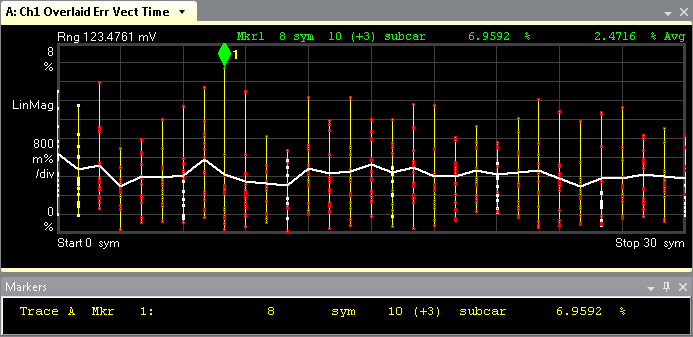Overlaid Error Vector Time (TEDS)
shows error vector time for all the TEDS subcarrierscorresponding to your Channel Bandwidth setting, on a symbol-by-symbol basis. Each vertical line represents a symbol which has color for data symbols and white for sync (first two symbols for this example), pilot, and header symbols (if parameter Header Symbols is cleared).
The number of symbols (vertical lines) is determined by the slot formal selected. These lines are overlaid with a white trace that shows the average error vector time per symbol (LinMag and LogMag only). The image below is a Normal Uplink, 50kHz channel bandwidth, 16QAM modulation signal. The 31 colored vertical lines (0 to 30) represent the 31 symbols in a Normal Uplink slot format. Each line contains the 16 subcarriers corresponding to the 50kHz channel bandwidth. See TEDS Subcarriers for more information on the number of subcarriers for each channel bandwidth.

Select to scale the trace. If the trace shows NO DATA, check your recorded signal or hardware input and TEDS demod properties. TEDS demod parameters Droop and Pilot Tracking affect this trace. The above trace shows a LinMag (linear magnitude) scale. To change scales, see and choose from the drop-down menu.
Select to place a marker on the trace and then review the symbol information in the marker readout window. Once you have a marker on the trace, use your up, down, left and right arrow keys to move the marker through the symbol points.
Error Vector Time measurements are useful to discover time-based signal impairments from impulsive, transient, overloads, or other time-related disturbance, including poor equalizer function and variations from burst-to-burst.
To view Error Vector Time for specific subcarrier, see Error Vector Time (Subcarr).
See Also
